Comprehensive Marketing Report: IKEA's Strategies and Market Analysis
VerifiedAdded on 2024/05/17
|24
|5337
|392
Report
AI Summary
This report provides a comprehensive marketing analysis of IKEA, the world's largest furniture retailer. It begins with an executive summary and an introduction to IKEA's global presence and product range. The core of the report involves a thorough internal and external analysis, including a SWOT analysis that identifies IKEA's strengths (e.g., low prices, green practices), weaknesses (e.g., reliance on suppliers), opportunities (e.g., emerging markets), and threats (e.g., competition). A PESTEL analysis examines the political, economic, social, technological, environmental, and legal factors impacting IKEA's operations. Porter's Five Forces analysis evaluates industry rivalry, the threat of new entrants, and the threat of substitutes. The report then details IKEA's present marketing strategy, objectives, and segmentation, targeting, and positioning (STP) approach. Key marketing programs are discussed, alongside new market offerings like the IKEA Family Card and the IKEA Place app. The conclusion summarizes the key findings and recommendations based on the analysis.
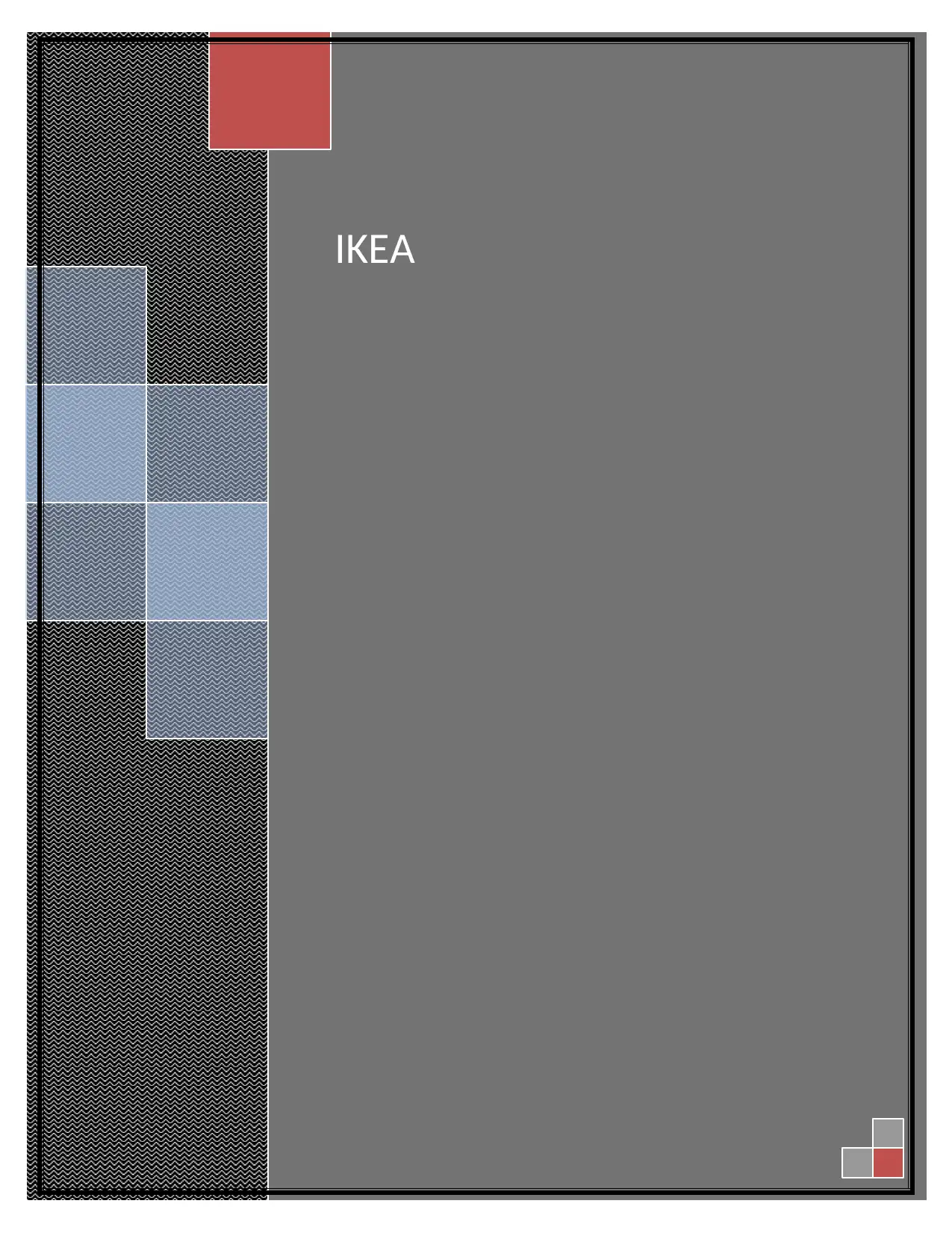
IKEA
Paraphrase This Document
Need a fresh take? Get an instant paraphrase of this document with our AI Paraphraser
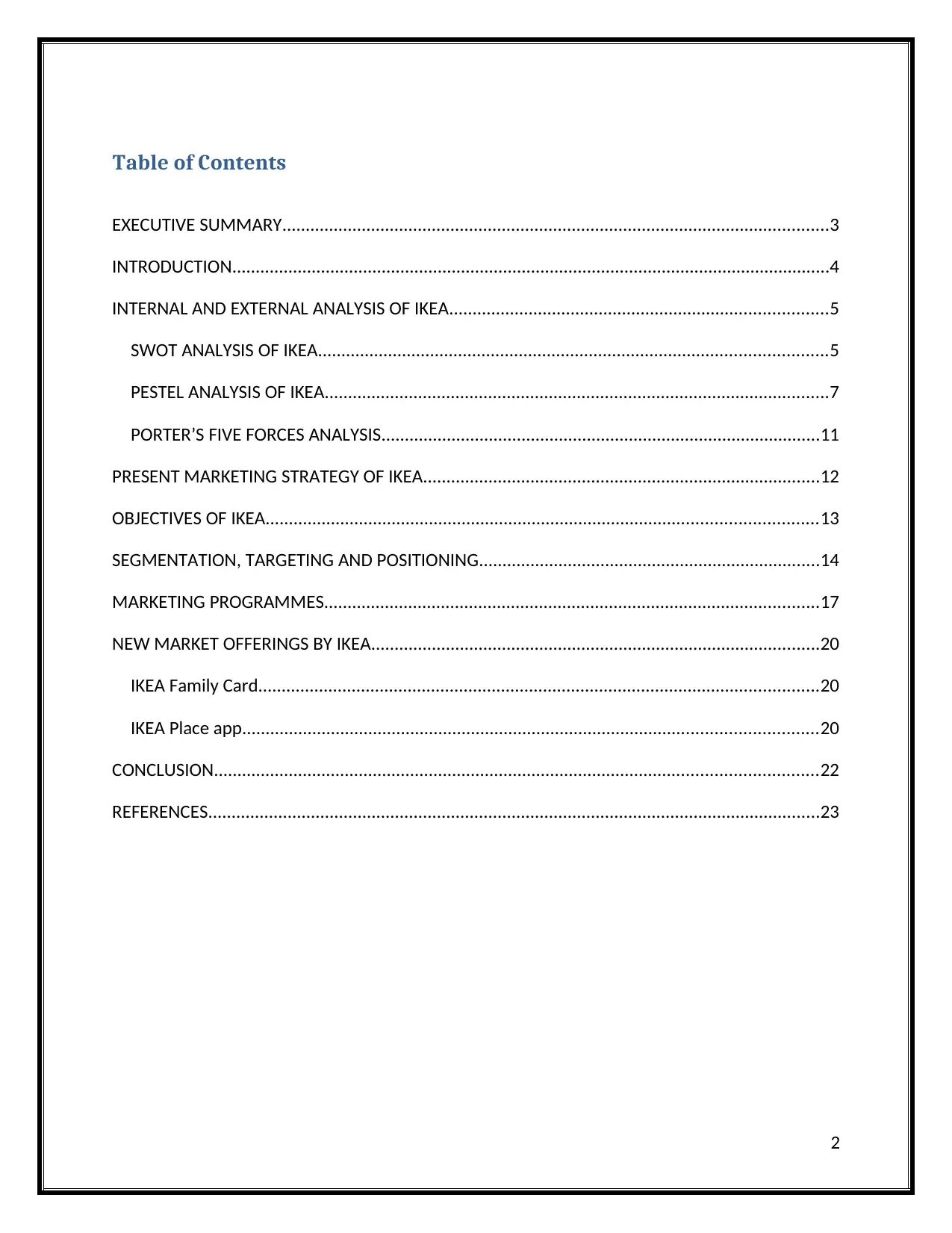
Table of Contents
EXECUTIVE SUMMARY.....................................................................................................................3
INTRODUCTION................................................................................................................................4
INTERNAL AND EXTERNAL ANALYSIS OF IKEA.................................................................................5
SWOT ANALYSIS OF IKEA.............................................................................................................5
PESTEL ANALYSIS OF IKEA............................................................................................................7
PORTER’S FIVE FORCES ANALYSIS..............................................................................................11
PRESENT MARKETING STRATEGY OF IKEA.....................................................................................12
OBJECTIVES OF IKEA......................................................................................................................13
SEGMENTATION, TARGETING AND POSITIONING.........................................................................14
MARKETING PROGRAMMES..........................................................................................................17
NEW MARKET OFFERINGS BY IKEA................................................................................................20
IKEA Family Card........................................................................................................................20
IKEA Place app...........................................................................................................................20
CONCLUSION.................................................................................................................................22
REFERENCES...................................................................................................................................23
2
EXECUTIVE SUMMARY.....................................................................................................................3
INTRODUCTION................................................................................................................................4
INTERNAL AND EXTERNAL ANALYSIS OF IKEA.................................................................................5
SWOT ANALYSIS OF IKEA.............................................................................................................5
PESTEL ANALYSIS OF IKEA............................................................................................................7
PORTER’S FIVE FORCES ANALYSIS..............................................................................................11
PRESENT MARKETING STRATEGY OF IKEA.....................................................................................12
OBJECTIVES OF IKEA......................................................................................................................13
SEGMENTATION, TARGETING AND POSITIONING.........................................................................14
MARKETING PROGRAMMES..........................................................................................................17
NEW MARKET OFFERINGS BY IKEA................................................................................................20
IKEA Family Card........................................................................................................................20
IKEA Place app...........................................................................................................................20
CONCLUSION.................................................................................................................................22
REFERENCES...................................................................................................................................23
2
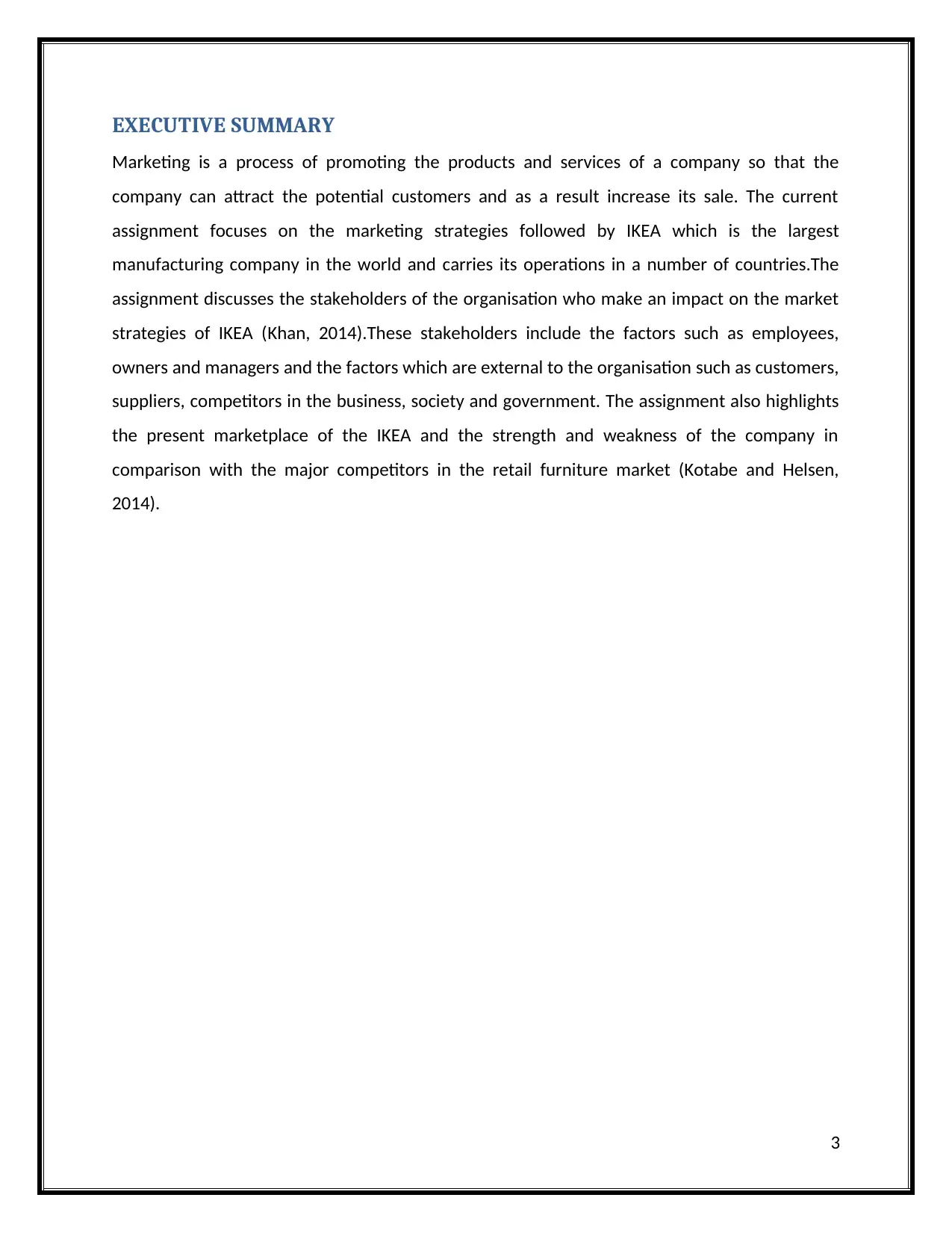
EXECUTIVE SUMMARY
Marketing is a process of promoting the products and services of a company so that the
company can attract the potential customers and as a result increase its sale. The current
assignment focuses on the marketing strategies followed by IKEA which is the largest
manufacturing company in the world and carries its operations in a number of countries.The
assignment discusses the stakeholders of the organisation who make an impact on the market
strategies of IKEA (Khan, 2014).These stakeholders include the factors such as employees,
owners and managers and the factors which are external to the organisation such as customers,
suppliers, competitors in the business, society and government. The assignment also highlights
the present marketplace of the IKEA and the strength and weakness of the company in
comparison with the major competitors in the retail furniture market (Kotabe and Helsen,
2014).
3
Marketing is a process of promoting the products and services of a company so that the
company can attract the potential customers and as a result increase its sale. The current
assignment focuses on the marketing strategies followed by IKEA which is the largest
manufacturing company in the world and carries its operations in a number of countries.The
assignment discusses the stakeholders of the organisation who make an impact on the market
strategies of IKEA (Khan, 2014).These stakeholders include the factors such as employees,
owners and managers and the factors which are external to the organisation such as customers,
suppliers, competitors in the business, society and government. The assignment also highlights
the present marketplace of the IKEA and the strength and weakness of the company in
comparison with the major competitors in the retail furniture market (Kotabe and Helsen,
2014).
3
⊘ This is a preview!⊘
Do you want full access?
Subscribe today to unlock all pages.

Trusted by 1+ million students worldwide
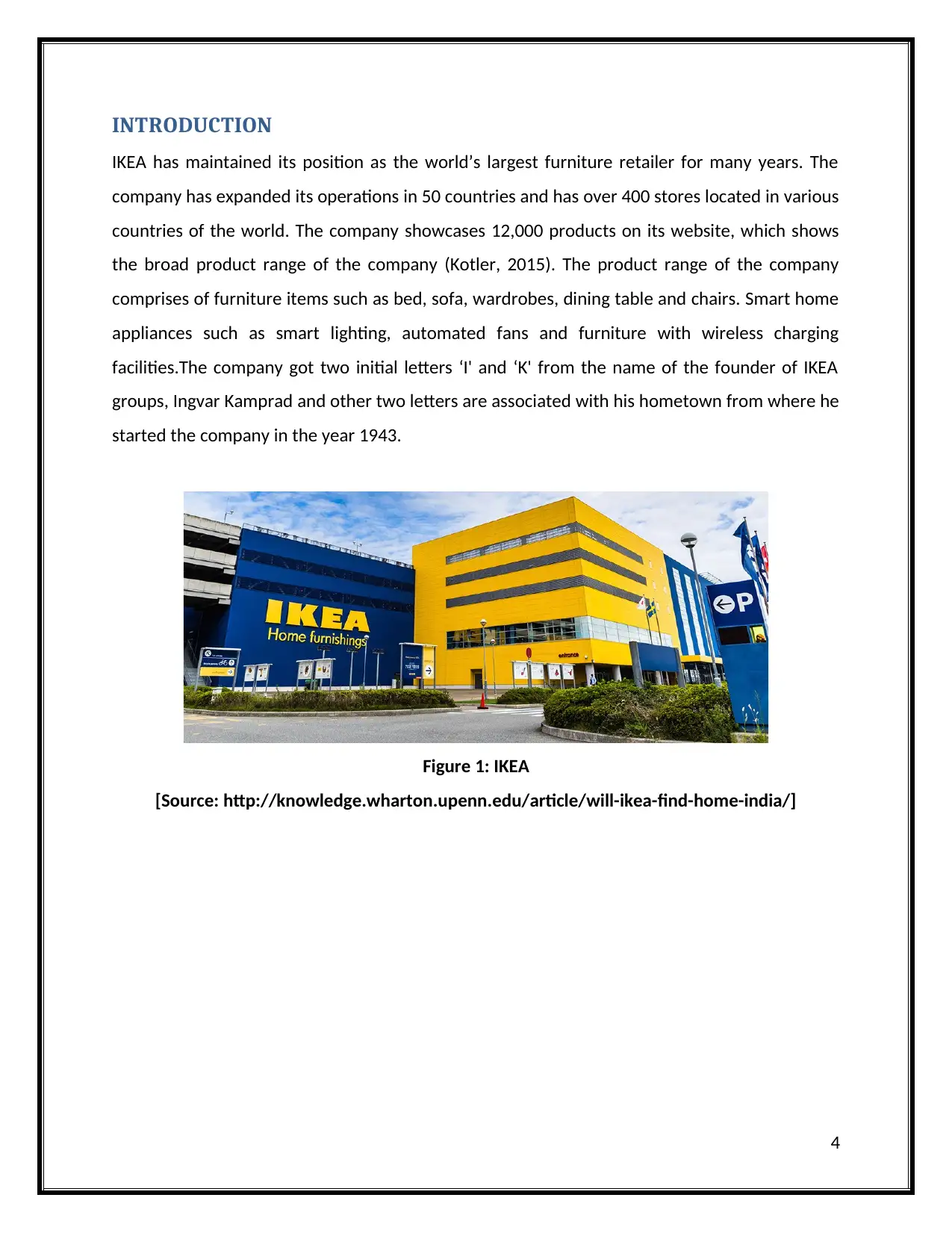
INTRODUCTION
IKEA has maintained its position as the world’s largest furniture retailer for many years. The
company has expanded its operations in 50 countries and has over 400 stores located in various
countries of the world. The company showcases 12,000 products on its website, which shows
the broad product range of the company (Kotler, 2015). The product range of the company
comprises of furniture items such as bed, sofa, wardrobes, dining table and chairs. Smart home
appliances such as smart lighting, automated fans and furniture with wireless charging
facilities.The company got two initial letters ‘I' and ‘K' from the name of the founder of IKEA
groups, Ingvar Kamprad and other two letters are associated with his hometown from where he
started the company in the year 1943.
Figure 1: IKEA
[Source: http://knowledge.wharton.upenn.edu/article/will-ikea-find-home-india/]
4
IKEA has maintained its position as the world’s largest furniture retailer for many years. The
company has expanded its operations in 50 countries and has over 400 stores located in various
countries of the world. The company showcases 12,000 products on its website, which shows
the broad product range of the company (Kotler, 2015). The product range of the company
comprises of furniture items such as bed, sofa, wardrobes, dining table and chairs. Smart home
appliances such as smart lighting, automated fans and furniture with wireless charging
facilities.The company got two initial letters ‘I' and ‘K' from the name of the founder of IKEA
groups, Ingvar Kamprad and other two letters are associated with his hometown from where he
started the company in the year 1943.
Figure 1: IKEA
[Source: http://knowledge.wharton.upenn.edu/article/will-ikea-find-home-india/]
4
Paraphrase This Document
Need a fresh take? Get an instant paraphrase of this document with our AI Paraphraser
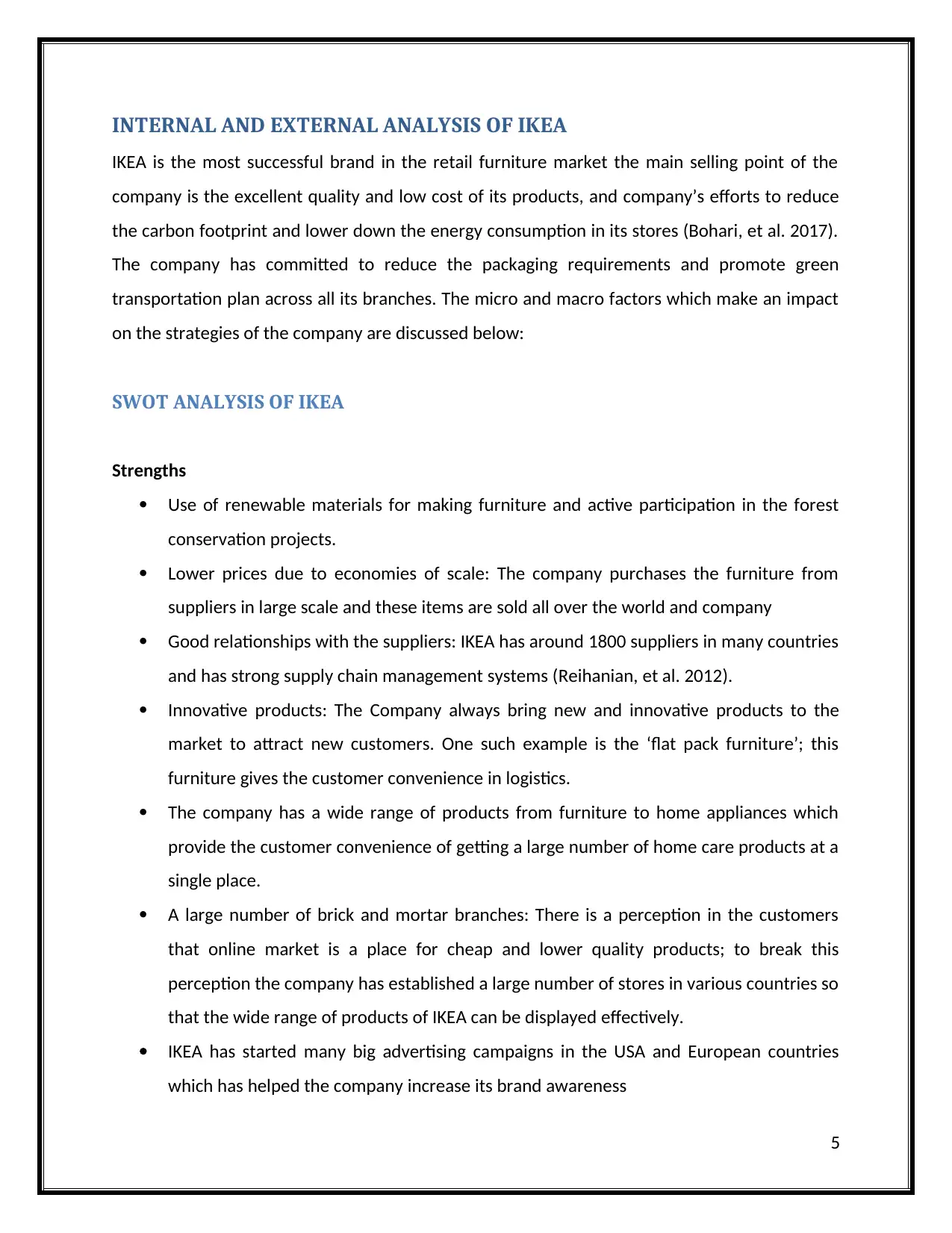
INTERNAL AND EXTERNAL ANALYSIS OF IKEA
IKEA is the most successful brand in the retail furniture market the main selling point of the
company is the excellent quality and low cost of its products, and company’s efforts to reduce
the carbon footprint and lower down the energy consumption in its stores (Bohari, et al. 2017).
The company has committed to reduce the packaging requirements and promote green
transportation plan across all its branches. The micro and macro factors which make an impact
on the strategies of the company are discussed below:
SWOT ANALYSIS OF IKEA
Strengths
Use of renewable materials for making furniture and active participation in the forest
conservation projects.
Lower prices due to economies of scale: The company purchases the furniture from
suppliers in large scale and these items are sold all over the world and company
Good relationships with the suppliers: IKEA has around 1800 suppliers in many countries
and has strong supply chain management systems (Reihanian, et al. 2012).
Innovative products: The Company always bring new and innovative products to the
market to attract new customers. One such example is the ‘flat pack furniture’; this
furniture gives the customer convenience in logistics.
The company has a wide range of products from furniture to home appliances which
provide the customer convenience of getting a large number of home care products at a
single place.
A large number of brick and mortar branches: There is a perception in the customers
that online market is a place for cheap and lower quality products; to break this
perception the company has established a large number of stores in various countries so
that the wide range of products of IKEA can be displayed effectively.
IKEA has started many big advertising campaigns in the USA and European countries
which has helped the company increase its brand awareness
5
IKEA is the most successful brand in the retail furniture market the main selling point of the
company is the excellent quality and low cost of its products, and company’s efforts to reduce
the carbon footprint and lower down the energy consumption in its stores (Bohari, et al. 2017).
The company has committed to reduce the packaging requirements and promote green
transportation plan across all its branches. The micro and macro factors which make an impact
on the strategies of the company are discussed below:
SWOT ANALYSIS OF IKEA
Strengths
Use of renewable materials for making furniture and active participation in the forest
conservation projects.
Lower prices due to economies of scale: The company purchases the furniture from
suppliers in large scale and these items are sold all over the world and company
Good relationships with the suppliers: IKEA has around 1800 suppliers in many countries
and has strong supply chain management systems (Reihanian, et al. 2012).
Innovative products: The Company always bring new and innovative products to the
market to attract new customers. One such example is the ‘flat pack furniture’; this
furniture gives the customer convenience in logistics.
The company has a wide range of products from furniture to home appliances which
provide the customer convenience of getting a large number of home care products at a
single place.
A large number of brick and mortar branches: There is a perception in the customers
that online market is a place for cheap and lower quality products; to break this
perception the company has established a large number of stores in various countries so
that the wide range of products of IKEA can be displayed effectively.
IKEA has started many big advertising campaigns in the USA and European countries
which has helped the company increase its brand awareness
5
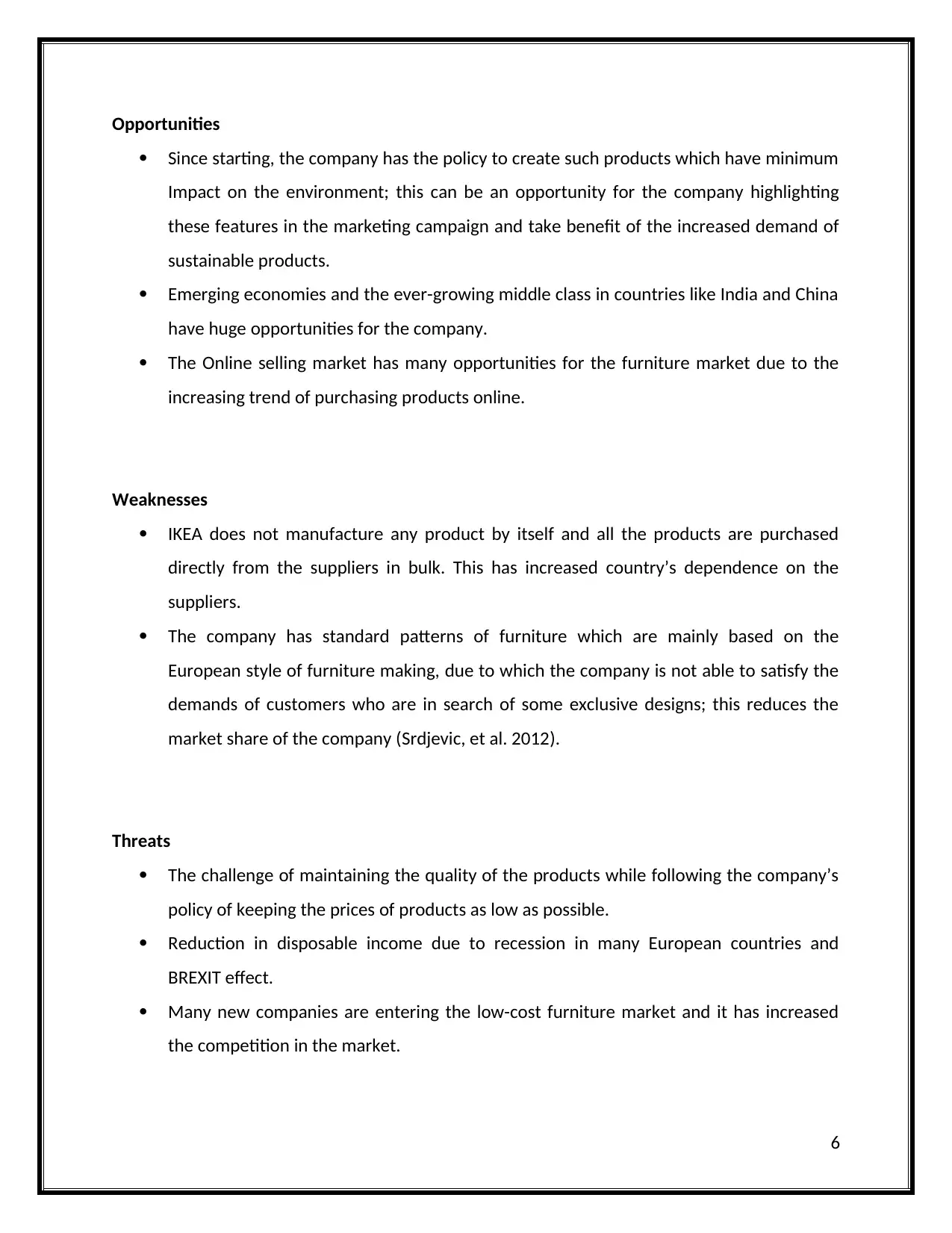
Opportunities
Since starting, the company has the policy to create such products which have minimum
Impact on the environment; this can be an opportunity for the company highlighting
these features in the marketing campaign and take benefit of the increased demand of
sustainable products.
Emerging economies and the ever-growing middle class in countries like India and China
have huge opportunities for the company.
The Online selling market has many opportunities for the furniture market due to the
increasing trend of purchasing products online.
Weaknesses
IKEA does not manufacture any product by itself and all the products are purchased
directly from the suppliers in bulk. This has increased country’s dependence on the
suppliers.
The company has standard patterns of furniture which are mainly based on the
European style of furniture making, due to which the company is not able to satisfy the
demands of customers who are in search of some exclusive designs; this reduces the
market share of the company (Srdjevic, et al. 2012).
Threats
The challenge of maintaining the quality of the products while following the company’s
policy of keeping the prices of products as low as possible.
Reduction in disposable income due to recession in many European countries and
BREXIT effect.
Many new companies are entering the low-cost furniture market and it has increased
the competition in the market.
6
Since starting, the company has the policy to create such products which have minimum
Impact on the environment; this can be an opportunity for the company highlighting
these features in the marketing campaign and take benefit of the increased demand of
sustainable products.
Emerging economies and the ever-growing middle class in countries like India and China
have huge opportunities for the company.
The Online selling market has many opportunities for the furniture market due to the
increasing trend of purchasing products online.
Weaknesses
IKEA does not manufacture any product by itself and all the products are purchased
directly from the suppliers in bulk. This has increased country’s dependence on the
suppliers.
The company has standard patterns of furniture which are mainly based on the
European style of furniture making, due to which the company is not able to satisfy the
demands of customers who are in search of some exclusive designs; this reduces the
market share of the company (Srdjevic, et al. 2012).
Threats
The challenge of maintaining the quality of the products while following the company’s
policy of keeping the prices of products as low as possible.
Reduction in disposable income due to recession in many European countries and
BREXIT effect.
Many new companies are entering the low-cost furniture market and it has increased
the competition in the market.
6
⊘ This is a preview!⊘
Do you want full access?
Subscribe today to unlock all pages.

Trusted by 1+ million students worldwide
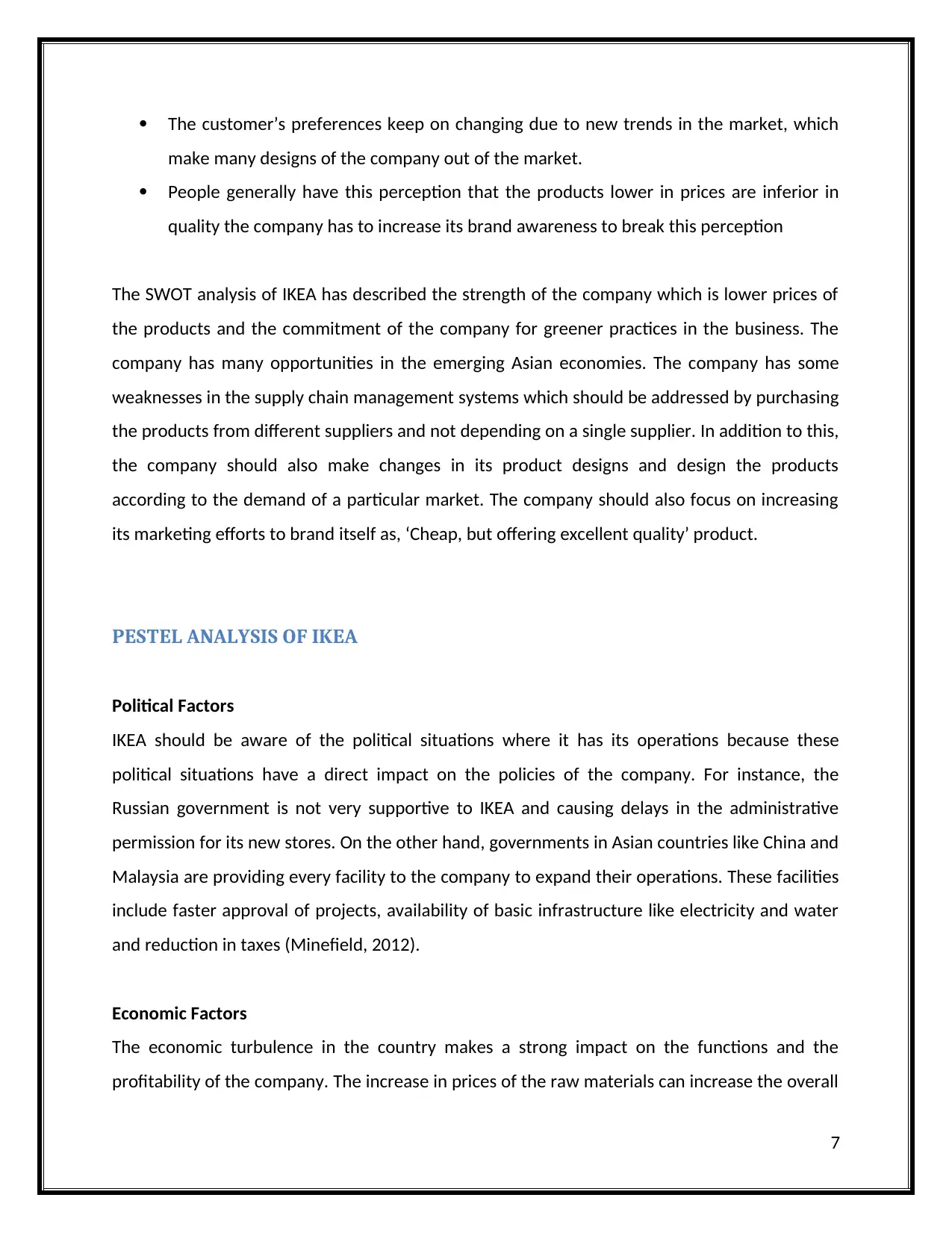
The customer’s preferences keep on changing due to new trends in the market, which
make many designs of the company out of the market.
People generally have this perception that the products lower in prices are inferior in
quality the company has to increase its brand awareness to break this perception
The SWOT analysis of IKEA has described the strength of the company which is lower prices of
the products and the commitment of the company for greener practices in the business. The
company has many opportunities in the emerging Asian economies. The company has some
weaknesses in the supply chain management systems which should be addressed by purchasing
the products from different suppliers and not depending on a single supplier. In addition to this,
the company should also make changes in its product designs and design the products
according to the demand of a particular market. The company should also focus on increasing
its marketing efforts to brand itself as, ‘Cheap, but offering excellent quality’ product.
PESTEL ANALYSIS OF IKEA
Political Factors
IKEA should be aware of the political situations where it has its operations because these
political situations have a direct impact on the policies of the company. For instance, the
Russian government is not very supportive to IKEA and causing delays in the administrative
permission for its new stores. On the other hand, governments in Asian countries like China and
Malaysia are providing every facility to the company to expand their operations. These facilities
include faster approval of projects, availability of basic infrastructure like electricity and water
and reduction in taxes (Minefield, 2012).
Economic Factors
The economic turbulence in the country makes a strong impact on the functions and the
profitability of the company. The increase in prices of the raw materials can increase the overall
7
make many designs of the company out of the market.
People generally have this perception that the products lower in prices are inferior in
quality the company has to increase its brand awareness to break this perception
The SWOT analysis of IKEA has described the strength of the company which is lower prices of
the products and the commitment of the company for greener practices in the business. The
company has many opportunities in the emerging Asian economies. The company has some
weaknesses in the supply chain management systems which should be addressed by purchasing
the products from different suppliers and not depending on a single supplier. In addition to this,
the company should also make changes in its product designs and design the products
according to the demand of a particular market. The company should also focus on increasing
its marketing efforts to brand itself as, ‘Cheap, but offering excellent quality’ product.
PESTEL ANALYSIS OF IKEA
Political Factors
IKEA should be aware of the political situations where it has its operations because these
political situations have a direct impact on the policies of the company. For instance, the
Russian government is not very supportive to IKEA and causing delays in the administrative
permission for its new stores. On the other hand, governments in Asian countries like China and
Malaysia are providing every facility to the company to expand their operations. These facilities
include faster approval of projects, availability of basic infrastructure like electricity and water
and reduction in taxes (Minefield, 2012).
Economic Factors
The economic turbulence in the country makes a strong impact on the functions and the
profitability of the company. The increase in prices of the raw materials can increase the overall
7
Paraphrase This Document
Need a fresh take? Get an instant paraphrase of this document with our AI Paraphraser
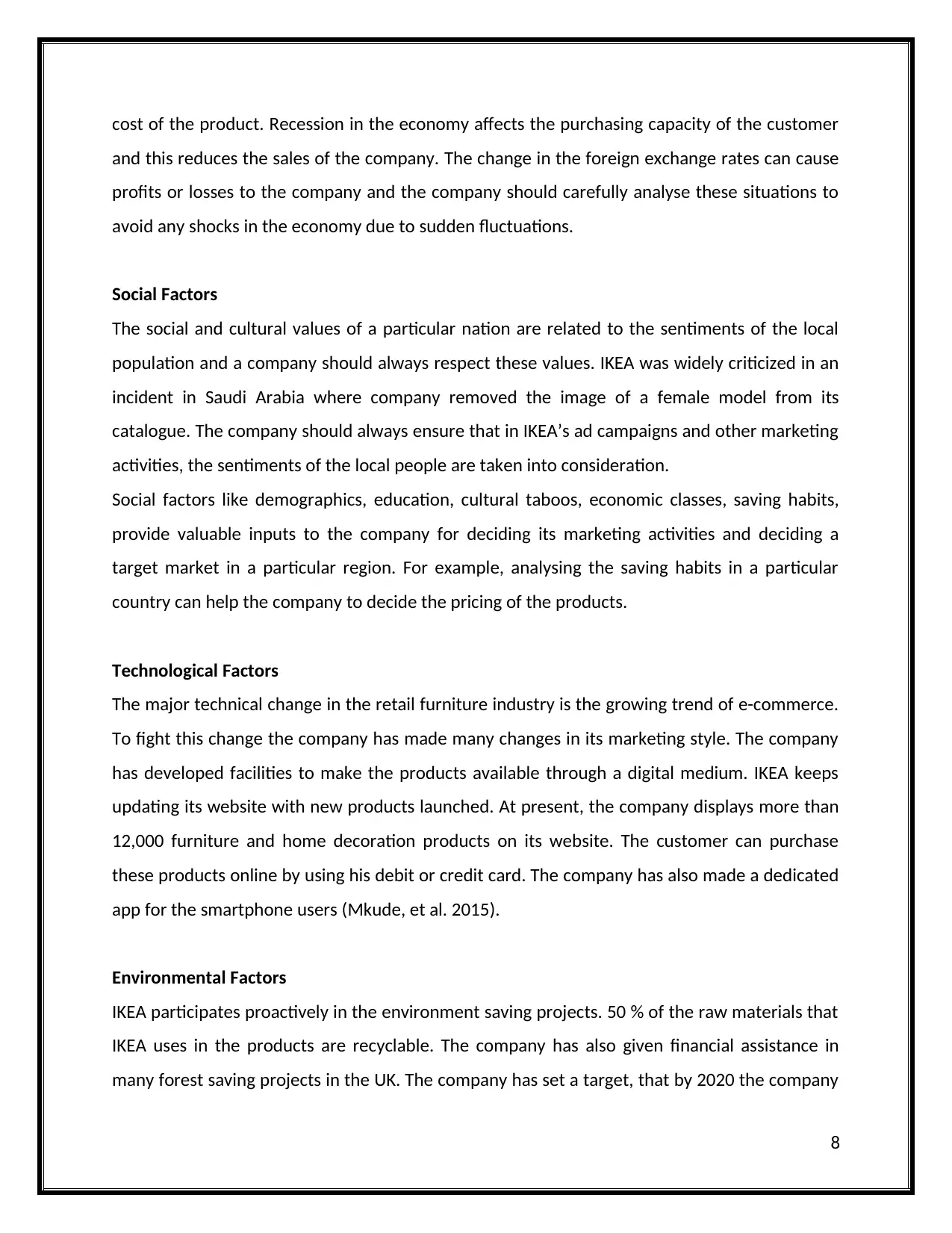
cost of the product. Recession in the economy affects the purchasing capacity of the customer
and this reduces the sales of the company. The change in the foreign exchange rates can cause
profits or losses to the company and the company should carefully analyse these situations to
avoid any shocks in the economy due to sudden fluctuations.
Social Factors
The social and cultural values of a particular nation are related to the sentiments of the local
population and a company should always respect these values. IKEA was widely criticized in an
incident in Saudi Arabia where company removed the image of a female model from its
catalogue. The company should always ensure that in IKEA’s ad campaigns and other marketing
activities, the sentiments of the local people are taken into consideration.
Social factors like demographics, education, cultural taboos, economic classes, saving habits,
provide valuable inputs to the company for deciding its marketing activities and deciding a
target market in a particular region. For example, analysing the saving habits in a particular
country can help the company to decide the pricing of the products.
Technological Factors
The major technical change in the retail furniture industry is the growing trend of e-commerce.
To fight this change the company has made many changes in its marketing style. The company
has developed facilities to make the products available through a digital medium. IKEA keeps
updating its website with new products launched. At present, the company displays more than
12,000 furniture and home decoration products on its website. The customer can purchase
these products online by using his debit or credit card. The company has also made a dedicated
app for the smartphone users (Mkude, et al. 2015).
Environmental Factors
IKEA participates proactively in the environment saving projects. 50 % of the raw materials that
IKEA uses in the products are recyclable. The company has also given financial assistance in
many forest saving projects in the UK. The company has set a target, that by 2020 the company
8
and this reduces the sales of the company. The change in the foreign exchange rates can cause
profits or losses to the company and the company should carefully analyse these situations to
avoid any shocks in the economy due to sudden fluctuations.
Social Factors
The social and cultural values of a particular nation are related to the sentiments of the local
population and a company should always respect these values. IKEA was widely criticized in an
incident in Saudi Arabia where company removed the image of a female model from its
catalogue. The company should always ensure that in IKEA’s ad campaigns and other marketing
activities, the sentiments of the local people are taken into consideration.
Social factors like demographics, education, cultural taboos, economic classes, saving habits,
provide valuable inputs to the company for deciding its marketing activities and deciding a
target market in a particular region. For example, analysing the saving habits in a particular
country can help the company to decide the pricing of the products.
Technological Factors
The major technical change in the retail furniture industry is the growing trend of e-commerce.
To fight this change the company has made many changes in its marketing style. The company
has developed facilities to make the products available through a digital medium. IKEA keeps
updating its website with new products launched. At present, the company displays more than
12,000 furniture and home decoration products on its website. The customer can purchase
these products online by using his debit or credit card. The company has also made a dedicated
app for the smartphone users (Mkude, et al. 2015).
Environmental Factors
IKEA participates proactively in the environment saving projects. 50 % of the raw materials that
IKEA uses in the products are recyclable. The company has also given financial assistance in
many forest saving projects in the UK. The company has set a target, that by 2020 the company
8
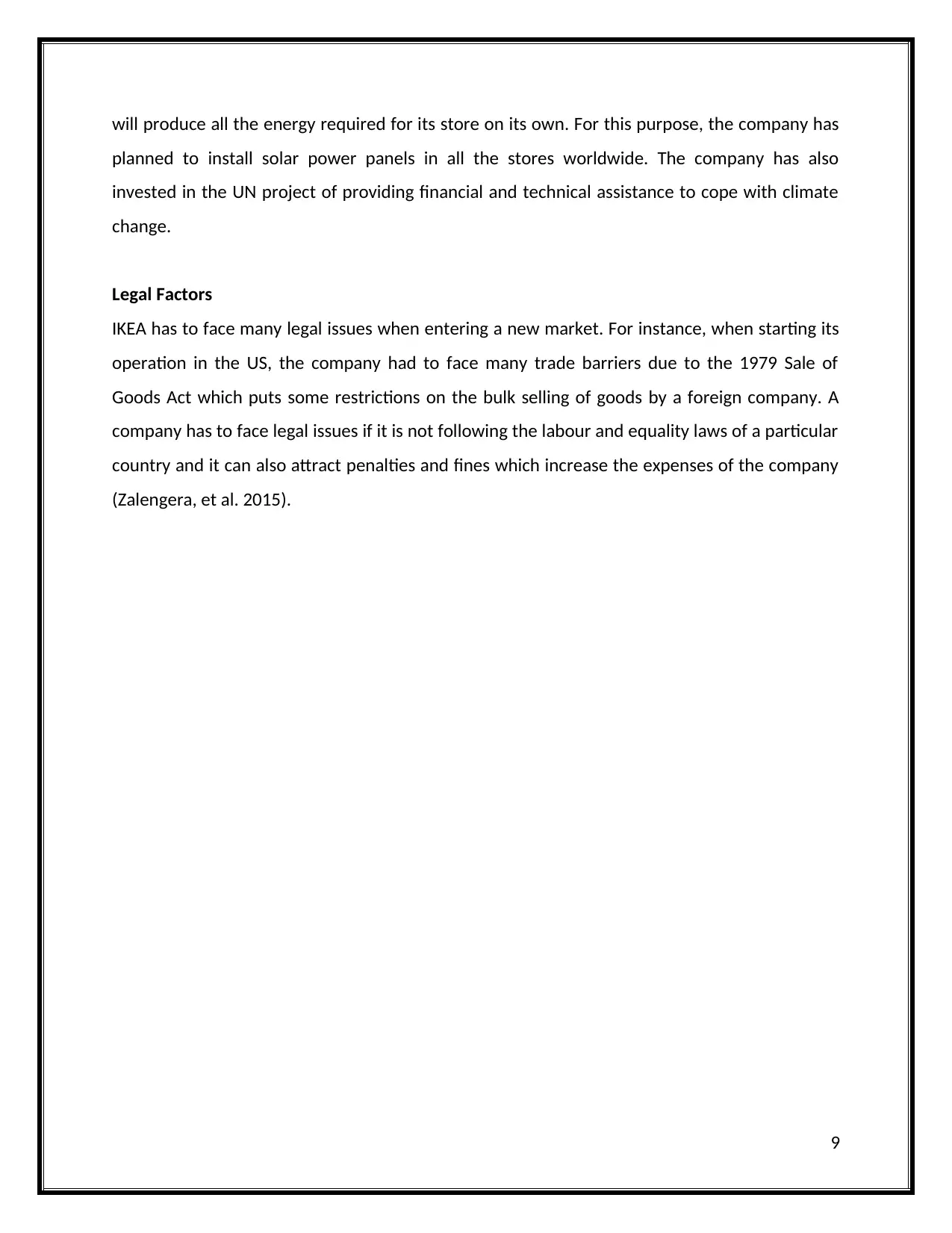
will produce all the energy required for its store on its own. For this purpose, the company has
planned to install solar power panels in all the stores worldwide. The company has also
invested in the UN project of providing financial and technical assistance to cope with climate
change.
Legal Factors
IKEA has to face many legal issues when entering a new market. For instance, when starting its
operation in the US, the company had to face many trade barriers due to the 1979 Sale of
Goods Act which puts some restrictions on the bulk selling of goods by a foreign company. A
company has to face legal issues if it is not following the labour and equality laws of a particular
country and it can also attract penalties and fines which increase the expenses of the company
(Zalengera, et al. 2015).
9
planned to install solar power panels in all the stores worldwide. The company has also
invested in the UN project of providing financial and technical assistance to cope with climate
change.
Legal Factors
IKEA has to face many legal issues when entering a new market. For instance, when starting its
operation in the US, the company had to face many trade barriers due to the 1979 Sale of
Goods Act which puts some restrictions on the bulk selling of goods by a foreign company. A
company has to face legal issues if it is not following the labour and equality laws of a particular
country and it can also attract penalties and fines which increase the expenses of the company
(Zalengera, et al. 2015).
9
⊘ This is a preview!⊘
Do you want full access?
Subscribe today to unlock all pages.

Trusted by 1+ million students worldwide
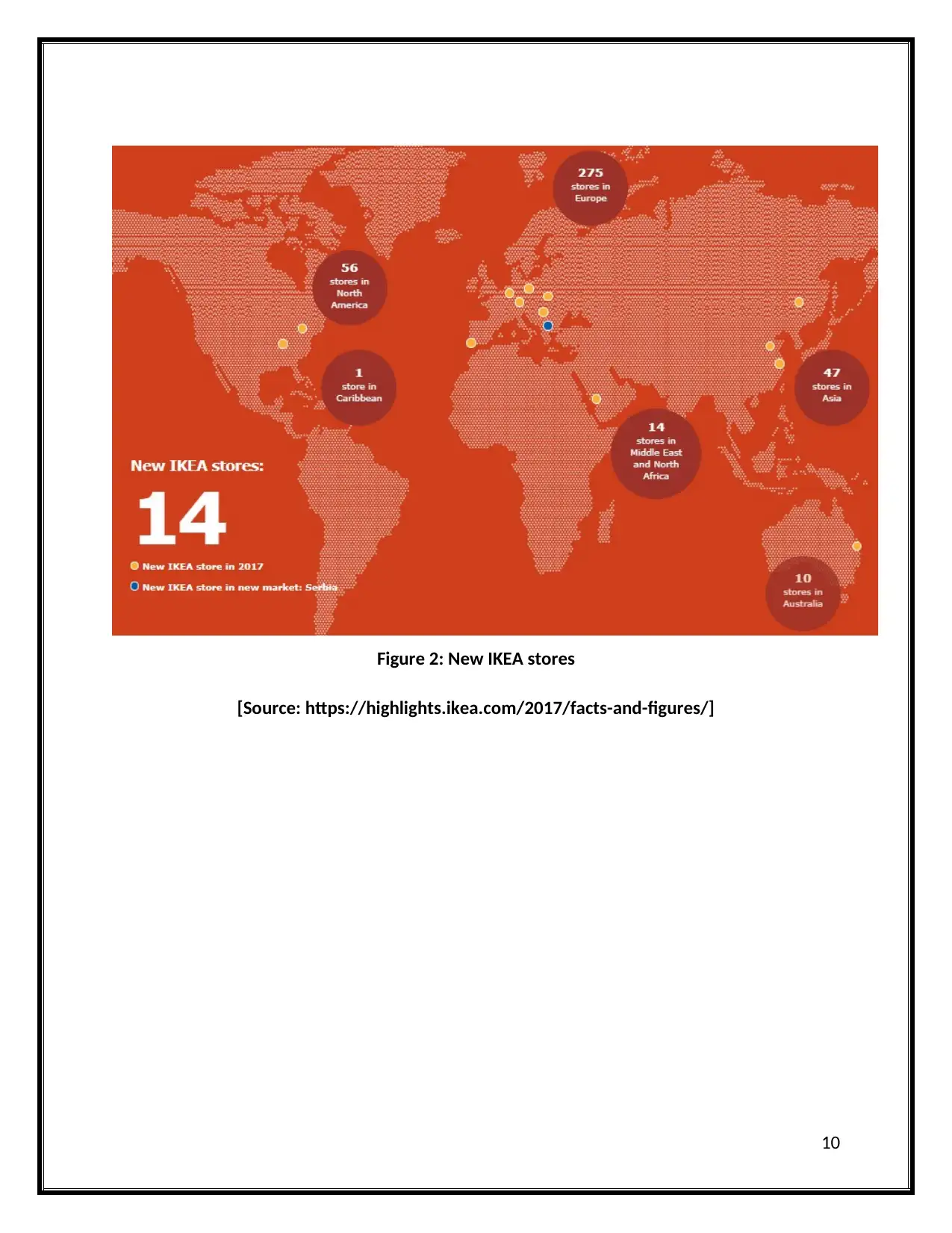
Figure 2: New IKEA stores
[Source: https://highlights.ikea.com/2017/facts-and-figures/]
10
[Source: https://highlights.ikea.com/2017/facts-and-figures/]
10
Paraphrase This Document
Need a fresh take? Get an instant paraphrase of this document with our AI Paraphraser
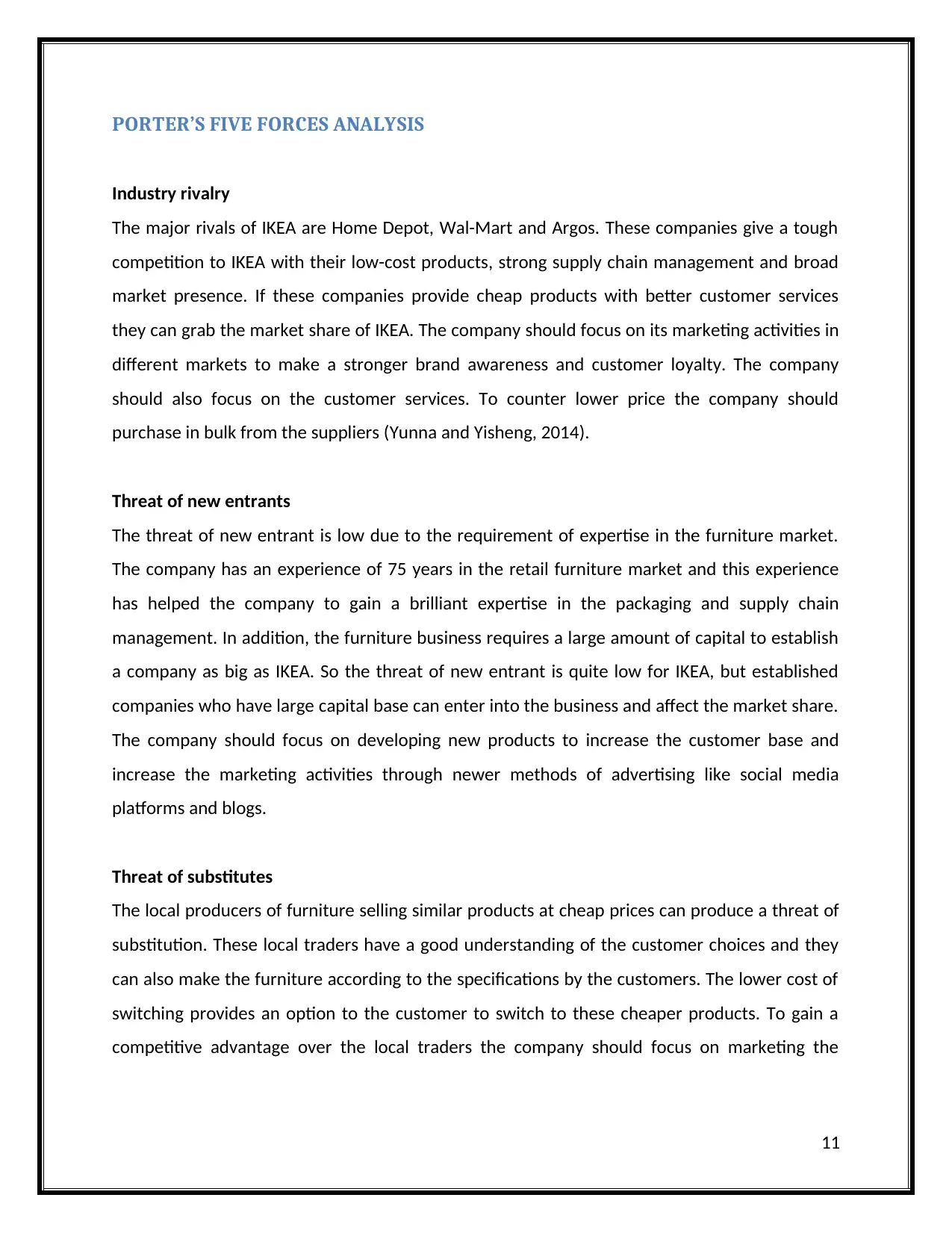
PORTER’S FIVE FORCES ANALYSIS
Industry rivalry
The major rivals of IKEA are Home Depot, Wal-Mart and Argos. These companies give a tough
competition to IKEA with their low-cost products, strong supply chain management and broad
market presence. If these companies provide cheap products with better customer services
they can grab the market share of IKEA. The company should focus on its marketing activities in
different markets to make a stronger brand awareness and customer loyalty. The company
should also focus on the customer services. To counter lower price the company should
purchase in bulk from the suppliers (Yunna and Yisheng, 2014).
Threat of new entrants
The threat of new entrant is low due to the requirement of expertise in the furniture market.
The company has an experience of 75 years in the retail furniture market and this experience
has helped the company to gain a brilliant expertise in the packaging and supply chain
management. In addition, the furniture business requires a large amount of capital to establish
a company as big as IKEA. So the threat of new entrant is quite low for IKEA, but established
companies who have large capital base can enter into the business and affect the market share.
The company should focus on developing new products to increase the customer base and
increase the marketing activities through newer methods of advertising like social media
platforms and blogs.
Threat of substitutes
The local producers of furniture selling similar products at cheap prices can produce a threat of
substitution. These local traders have a good understanding of the customer choices and they
can also make the furniture according to the specifications by the customers. The lower cost of
switching provides an option to the customer to switch to these cheaper products. To gain a
competitive advantage over the local traders the company should focus on marketing the
11
Industry rivalry
The major rivals of IKEA are Home Depot, Wal-Mart and Argos. These companies give a tough
competition to IKEA with their low-cost products, strong supply chain management and broad
market presence. If these companies provide cheap products with better customer services
they can grab the market share of IKEA. The company should focus on its marketing activities in
different markets to make a stronger brand awareness and customer loyalty. The company
should also focus on the customer services. To counter lower price the company should
purchase in bulk from the suppliers (Yunna and Yisheng, 2014).
Threat of new entrants
The threat of new entrant is low due to the requirement of expertise in the furniture market.
The company has an experience of 75 years in the retail furniture market and this experience
has helped the company to gain a brilliant expertise in the packaging and supply chain
management. In addition, the furniture business requires a large amount of capital to establish
a company as big as IKEA. So the threat of new entrant is quite low for IKEA, but established
companies who have large capital base can enter into the business and affect the market share.
The company should focus on developing new products to increase the customer base and
increase the marketing activities through newer methods of advertising like social media
platforms and blogs.
Threat of substitutes
The local producers of furniture selling similar products at cheap prices can produce a threat of
substitution. These local traders have a good understanding of the customer choices and they
can also make the furniture according to the specifications by the customers. The lower cost of
switching provides an option to the customer to switch to these cheaper products. To gain a
competitive advantage over the local traders the company should focus on marketing the
11
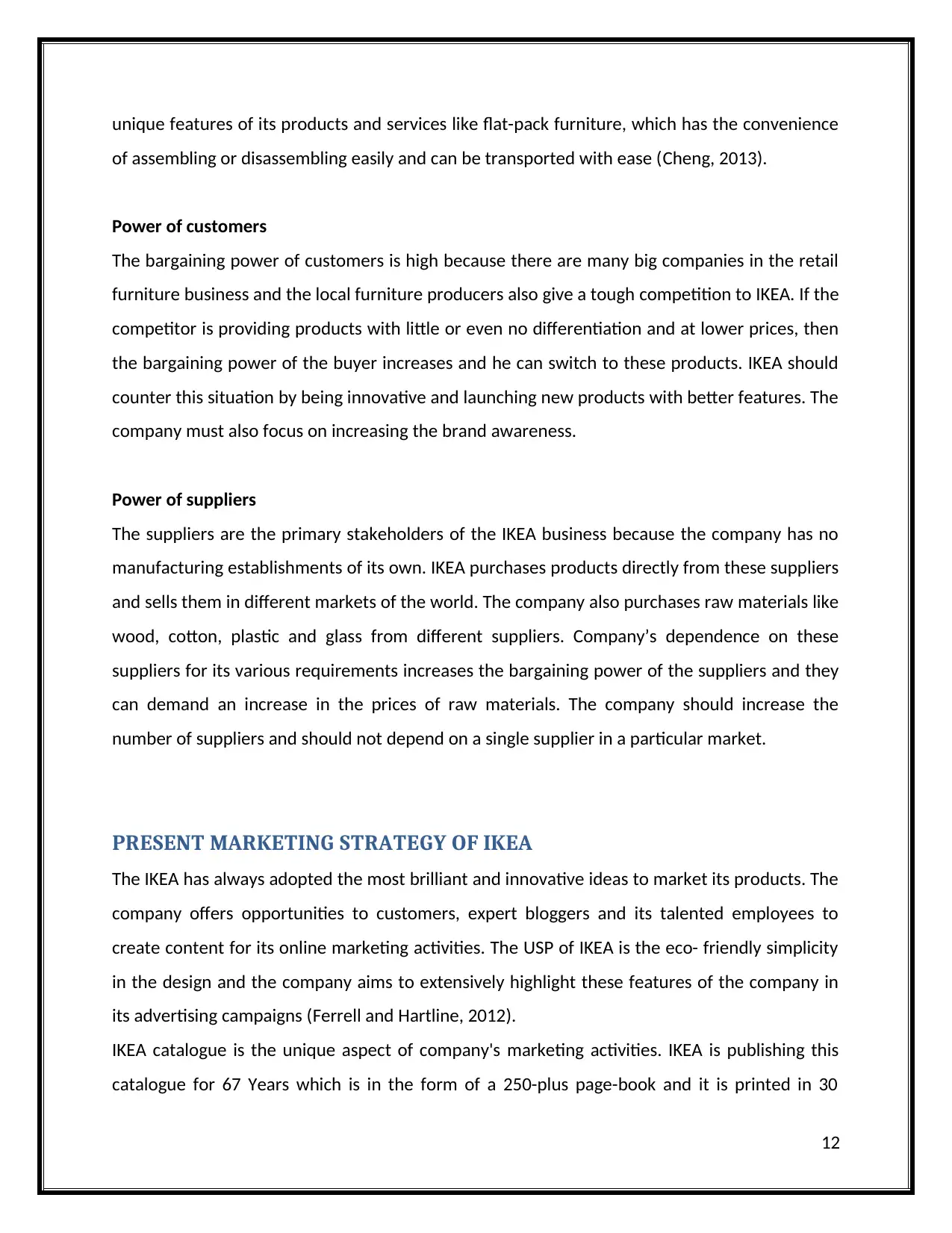
unique features of its products and services like flat-pack furniture, which has the convenience
of assembling or disassembling easily and can be transported with ease (Cheng, 2013).
Power of customers
The bargaining power of customers is high because there are many big companies in the retail
furniture business and the local furniture producers also give a tough competition to IKEA. If the
competitor is providing products with little or even no differentiation and at lower prices, then
the bargaining power of the buyer increases and he can switch to these products. IKEA should
counter this situation by being innovative and launching new products with better features. The
company must also focus on increasing the brand awareness.
Power of suppliers
The suppliers are the primary stakeholders of the IKEA business because the company has no
manufacturing establishments of its own. IKEA purchases products directly from these suppliers
and sells them in different markets of the world. The company also purchases raw materials like
wood, cotton, plastic and glass from different suppliers. Company’s dependence on these
suppliers for its various requirements increases the bargaining power of the suppliers and they
can demand an increase in the prices of raw materials. The company should increase the
number of suppliers and should not depend on a single supplier in a particular market.
PRESENT MARKETING STRATEGY OF IKEA
The IKEA has always adopted the most brilliant and innovative ideas to market its products. The
company offers opportunities to customers, expert bloggers and its talented employees to
create content for its online marketing activities. The USP of IKEA is the eco- friendly simplicity
in the design and the company aims to extensively highlight these features of the company in
its advertising campaigns (Ferrell and Hartline, 2012).
IKEA catalogue is the unique aspect of company's marketing activities. IKEA is publishing this
catalogue for 67 Years which is in the form of a 250-plus page-book and it is printed in 30
12
of assembling or disassembling easily and can be transported with ease (Cheng, 2013).
Power of customers
The bargaining power of customers is high because there are many big companies in the retail
furniture business and the local furniture producers also give a tough competition to IKEA. If the
competitor is providing products with little or even no differentiation and at lower prices, then
the bargaining power of the buyer increases and he can switch to these products. IKEA should
counter this situation by being innovative and launching new products with better features. The
company must also focus on increasing the brand awareness.
Power of suppliers
The suppliers are the primary stakeholders of the IKEA business because the company has no
manufacturing establishments of its own. IKEA purchases products directly from these suppliers
and sells them in different markets of the world. The company also purchases raw materials like
wood, cotton, plastic and glass from different suppliers. Company’s dependence on these
suppliers for its various requirements increases the bargaining power of the suppliers and they
can demand an increase in the prices of raw materials. The company should increase the
number of suppliers and should not depend on a single supplier in a particular market.
PRESENT MARKETING STRATEGY OF IKEA
The IKEA has always adopted the most brilliant and innovative ideas to market its products. The
company offers opportunities to customers, expert bloggers and its talented employees to
create content for its online marketing activities. The USP of IKEA is the eco- friendly simplicity
in the design and the company aims to extensively highlight these features of the company in
its advertising campaigns (Ferrell and Hartline, 2012).
IKEA catalogue is the unique aspect of company's marketing activities. IKEA is publishing this
catalogue for 67 Years which is in the form of a 250-plus page-book and it is printed in 30
12
⊘ This is a preview!⊘
Do you want full access?
Subscribe today to unlock all pages.

Trusted by 1+ million students worldwide
1 out of 24
Related Documents
Your All-in-One AI-Powered Toolkit for Academic Success.
+13062052269
info@desklib.com
Available 24*7 on WhatsApp / Email
![[object Object]](/_next/static/media/star-bottom.7253800d.svg)
Unlock your academic potential
Copyright © 2020–2025 A2Z Services. All Rights Reserved. Developed and managed by ZUCOL.





